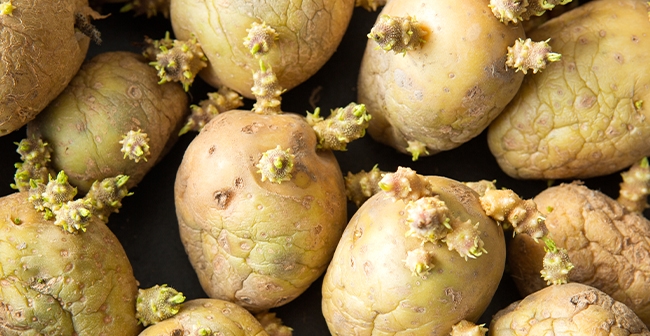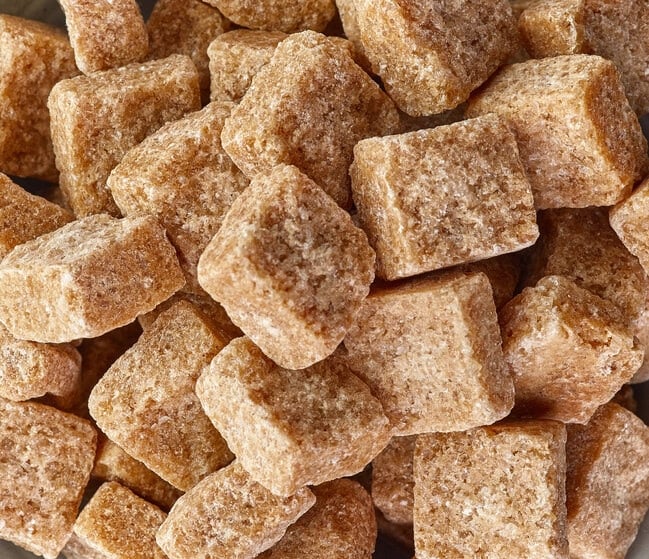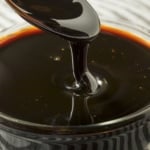When Good Food Looks Bad—But It’s Not!

Have you ever asked yourself, “is this okay to eat?” While it may be tempting to toss out food that looks unappetizing, it is important to remember that appearance is not always indicative of safety. For example, mold on hard cheeses can simply be cut off, and bruised produce is still perfectly fine to eat. But can you eat potatoes with sprouts? How about crystallized honey? Wondering how to soften hard brown sugar? Here are some common issues that cause many people to throw away good food. Use these tips to save your money and reduce food waste.
Can You Eat Potatoes With Sprouts?
You pull a potato out of the bag, and it has eyes popping out all over. Is it edible? Yes, as long as the potato is firm. Experts suggest that you remove and discard the sprouts before using the potatoes because the eyes contain mildly toxic compounds (known as glycoalkaloids) that increase as they grow. Use the end of a potato peeler to remove the eyes or peel the potato whole before cooking.

How About Crystallized Honey?
There is no expiration date on honey and while it may crystallize, it never goes bad. Why does honey crystallize? Honey crystalizes because of its high sugar and low water content. Warmer temperatures help honey stay liquid. Crystallization occurs over time when honey is stored below 95°F.
The good news is that you can easily de-crystallize honey in your kitchen. To do so, place a glass jar of honey in a pot of water on the stove top. The water should reach no higher than three quarters up the sides of the jar. Heat water in the pot over low to medium heat. Once the water is hot, stir the honey. Continue to stir gently every few minutes to dissolve the crystals. Once done, remove the hot honey jar with a jar lifter and set on a towel to cool slowly on your kitchen counter.

How To Soften Hard Brown Sugar
Brown sugar hardens when the molasses loses moisture, but that doesn’t mean you have to throw it away. Wondering how to soften hard brown sugar? Try one of these two simple solutions:
1) Place a bowl of brown sugar in the microwave. Fill a glass measuring cup with 1/3 cup water and set it in the microwave, too. Microwave for 30 seconds. Remove lumps with a fork. Pop back into the microwave for another 15 seconds, if needed.
2) Put a piece of bread or apple slices into an airtight container of hard brown sugar and leave it there overnight. The brown sugar will absorb the moisture from the bread or apple and soften.
Blood In Egg Yolks
Have you ever cracked open an egg and seen a blood spot? While it may seem gross, it is actually perfectly safe to eat. Blood in egg yolk is the result of a burst capillary in the hen’s ovary or yolk sac. This doesn’t mean the hen was unhealthy or mistreated, nor does it mean that the egg was fertilized. It’s more about the age of the chicken and her diet. If it really bothers you, simply remove the spot with a utensil and proceed with your recipe.
The “Best By” Date – Eggs, Milk, And Butter
Most grocery items today have “best by” dates stamped on them instead of expiration dates. The United States Department of Agriculture (USDA) advises that eggs, for example, are safe to use three to five weeks after purchase if kept in the coldest part of the refrigerator, not the door. Refrigerated milk can typically be used up to one week past the printed date. When in doubt, check for a sour or unpleasant smell or change in texture before drinking.
Butter, on the other hand, can be stored and used a month or so after the printed date when refrigerated in packaging at 40°F or below.
Note: You can freeze milk and keep it for up to six months, but it’s best to use after one month. Try to freeze it before it reaches the best by date. Butter can also be frozen for up to four months. Eggs can be frozen, too, but they need to be taken out of their shells first. (See page 84 in the 2023 Farmers’ Almanac for details.)
Read more about the FDA’s suggestions for “best if used by.”
Onions With Black Mold
The best rule with black mold is to avoid eating it. However, if the mold on the onion is minimal and easily removed, you can eat the onion. Rinse the onion under cool running water and use only if the remainder of it is firm and free of mold. Black mold on onions is caused by a common soil fungus, known as Aspergillus niger. If you have known allergies to Aspergillus niger, you should avoid contact with onions with black mold. If you notice black mold forming on your onions too often, you may deter it by storing the onions in the refrigerator.
Join The Discussion
Do you have questions about any of the foods mentioned above?
Did we answer your questions about crystallized honey or help you understand easy methods for how to soften hard brown sugar and more?
Share your thoughts with your community here in the comments below!
Related Articles

Deborah Tukua
Deborah Tukua is a natural living, healthy lifestyle writer and author of 7 non-fiction books, including Pearls of Garden Wisdom: Time-Saving Tips and Techniques from a Country Home, Pearls of Country Wisdom: Hints from a Small Town on Keeping Garden and Home, and Naturally Sweet Blender Treats. Tukua has been a writer for the Farmers' Almanac since 2004.






These are really helpful tips. Thank you for sharing. I will definitely pass these on.
We’re so glad to hear that, Margie! Best wishes from everyone at FA.